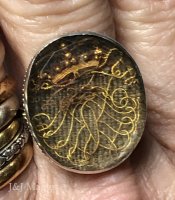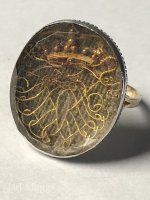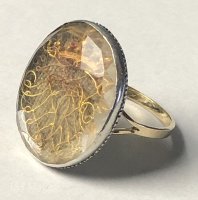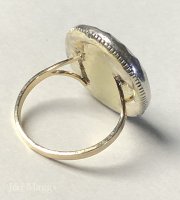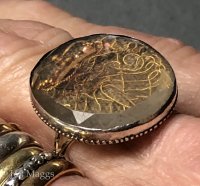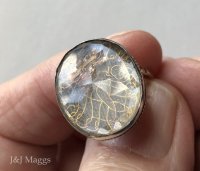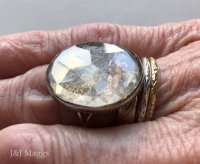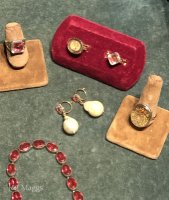Jan & John Maggs Antiques and Art
17th century Stuart crystal ring with foiled crown [27536]
Circa: 1690
$2350
Item Details
A splendid Stuart crystal gold and silver ring. The large, oval rose-cut crystal is set over a red-washed foil and a love token (woven hair) under a beaded gold crown and long swirling gold cypher device. The Stuart crystal (19.5 x 23mm) is closed-set in a silver bezel in a dog tooth mounting, covering the love token, scrolled gold cyphers, and gold wire and crown, all visible under the crystal. The gold shank, divided at the shoulders leading to an undecorated band at the verso, thus sizeable. It is currently between size 8 ½ and 8. A rare commemorative of Charles I of England, who died in 1649, these Stuart crystal pieces were only created in England and are highly prized. You will be wearing history on your hand. We have never seen another Stuart like this one.
*Stuart crystals have fascinated lovers of antique jewelry for many years, and for good reason. These beautiful gems were initially created in 1649, when King Charles I, the martyred King of England, was executed under Cromwell’s rule. People loyal to the Stuart monarchy (Royalists) wished to memorialize their lost King, to show their support and sympathy, by wearing slides, pendants, rings, earrings or cufflinks with his initials, crowns, or a likeness of the fallen King, set in gold or silver under a crystal. Thus, they became known as Stuart crystals, as they were commemorative of King Charles I, of the House of Stuart. Royalists opposed Charles I’s execution, believing that he was God’s chosen leader, and feeling that his death was not justice, but murder. Later in the 17th century, the crystals were worn by Jacobites against the deposition of James II and the Stuart monarchy in 1688. Showing support for fallen monarchs was dangerous, so many Stuart crystals were diminutive and were worn secretly.
These amazing pieces of jewelry were made up of clear, faceted rock crystals, enclosing love tokens (pieces of ribbon, cloth, or hair), with initials (sometimes the King’s monogram) worked in fine gold wire into cyphers on top, and a foil backing (rose, pink, red, silver, sometimes blue or green, in color). The whole mounting was closed-back set in silver or gold. This did not open but was rubbed over the crystal or sealed in a crimped manner.
Rarely does one find pieces which contain the highly prized hair of King Charles I. It is more usual to find Stuart crystal jewels with a miscellany of cyphers (in monogram) over the hair/fabric work, on top of the colored foil. Occasionally there are additional pieces of foil or filigree worked into angels, crowns, skulls, swags, skeletons, doves, etc., placed under the crystals, especially in slides or pendants if worn in memoriam. Later in the 17th century some Stuart pieces were worn as love tokens or wedding commemoratives, with symbols of love, i.e., hearts, putti, cherubs, or wreaths of flowers. This tradition continued through the reign of Queen Anne, who died in 1714, the last monarch of the House of Stuart.
Free domestic shipping is available on this item.
Click HERE to see a brief video of this piece.
Like to see more? CLICK HERE to visit our website.
Jan & John Maggs Antiques and Art
[email protected] Maggs
2 Old Cricket Hill Road
Conway, MA, 01341
United States
Phone: 4133694256
Visit Website
.jpg)
More Information
Booth 11
Shipping and Returns
Shipping: We offer free shipping through USPS for most smaller pieces, as noted in the item descriptions, and we will pack and arrange for the delivery of most others. For this latter group, we won’t charge for packing but will expect the buyer to pay the actual cost of shipping and insurance. For other pieces, we're happy to obtain quotes from reliable couriers and shippers. Please contact us with your address and ZIP code.Payment: We prefer payment by credit card or Zelle as well as by check from known buyers. PayPal Is an acceptable alternative. Payment by check usually will delay shipping until after payment is received.
Returns: We will refund the full amount of the purchase price if the article is not as described. These conditions will apply:
1. Returns must be requested within 24 hours of receipt of the piece.
2. The piece must not be “shopped around”, including the forwarding of photographs to prospective buyers.
3. Once we have approved a return, the refund will be made after the piece reaches us in the condition in which it was sent.
4. Buyers are responsible for return shipping costs.
Additional Information
When Jan, a collector of antique jewelry and period furniture, and John, a teacher and musicologist, met in the early 1980’s, it was no accident that their shared interests in music, art, and antiquities would morph into a rewarding enterprise. Jan’s family had been in the jewelry business since the 1800’s, and her passion for early jewels and period English furniture are grounded in this background. John’s career had been in the fields of teaching, conducting, and musicology, with an emphasis on the 16th and 17th centuries.When first together, they spent weekends buying at tag sales and Sunday flea markets. But soon they began to sell at these same markets as well as in two local multi-dealer shops. In 1985, as the fledgling business began to grow, they purchased a derelict 18th-century farmhouse and outbuildings in Conway, Massachusetts. Thus began a decades-long restoration project.
Even as the restoration demanded hours of exhausting labor, in addition to their day jobs, they began to exhibit at some of the myriad antiques shows throughout New England and New York, in one remarkably active year, exhibiting at 43 shows.
While initially focusing on American furniture and smalls, interests soon turned to the era with which they now live, early English oak. Following the leads of a few dealer friends, they made their first trip to England together in 1993, finding pieces they loved at prices that allowed them to bring them home and make them available at reasonable prices. Thus began a pattern of semi-annual buying trips to England, traveling in the spring and in the fall, with a gala opening in our shop soon after their return.
In February of 2017 the barn which they had passionately restored and turned into the home of their business was flattened by a freak tornado. Thanks to insurance companies that honored their obligations, they were able to design and build a new barn with comfortable and spacious showrooms in which early oak furniture, early jewelry, and paintings and accessories from the past four centuries can be displayed in room settings. John and Jan are eager to show off the new space and ever-evolving inventory, and they open the doors of the barn regularly to visitors who call for an appointment or who drop in by chance. If you visit our website, you'll find a link there to a recent video of the shop, so you can visit virtually in Conway, too. You'll also find a link on the home page through which you may easily sign up for our informative monthly e-newsletters.
![17th century Stuart crystal ring with foiled crown [27536]](https://nyantiques.us-east-1.linodeobjects.com/thumbs/173594164427536d.jpg)
